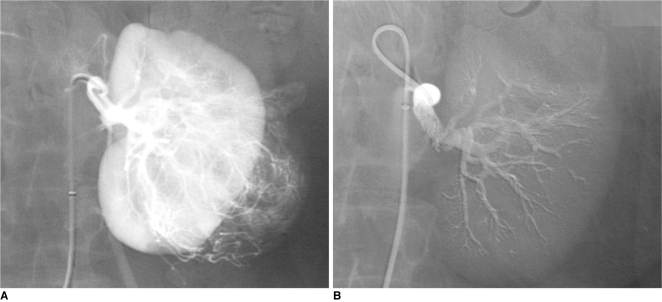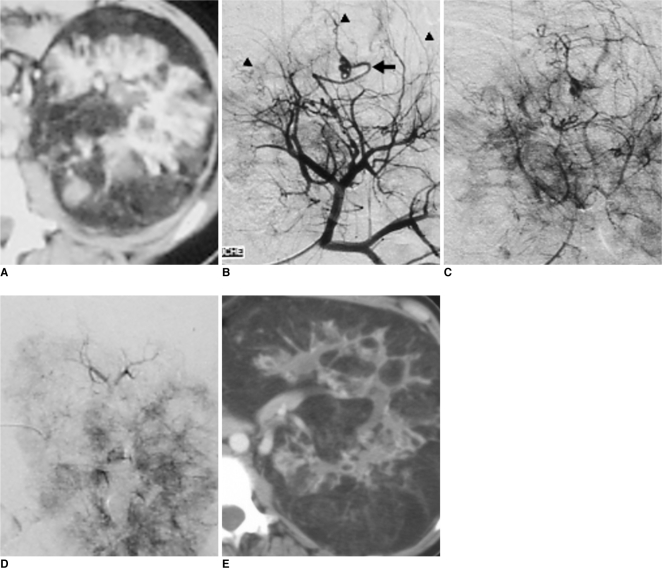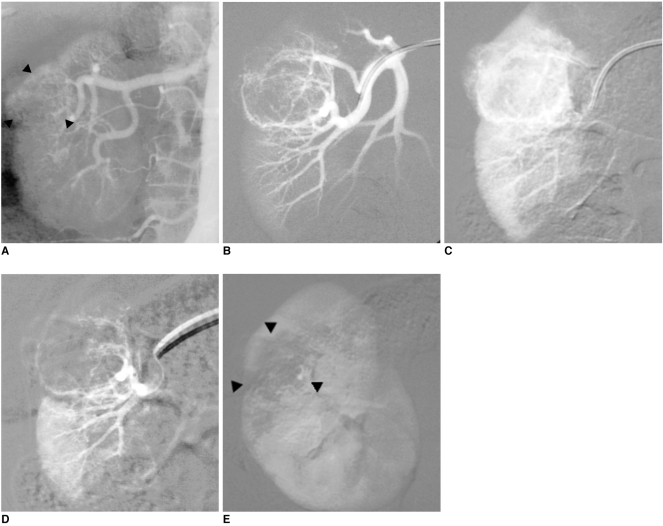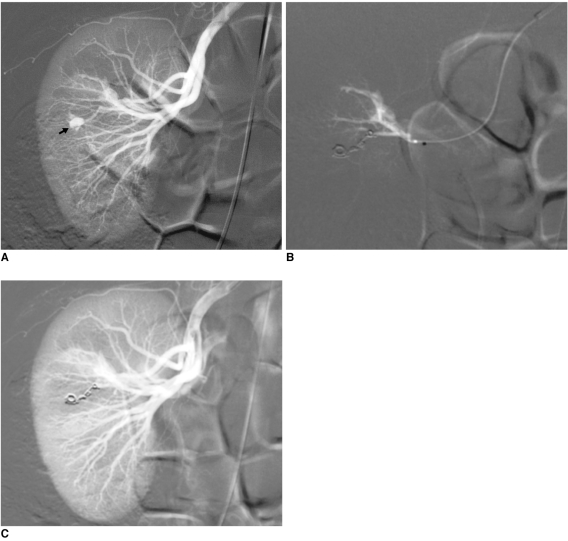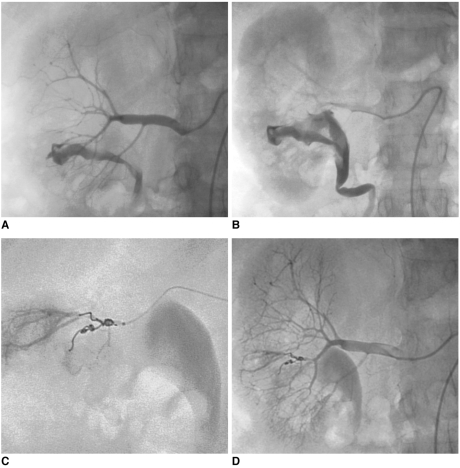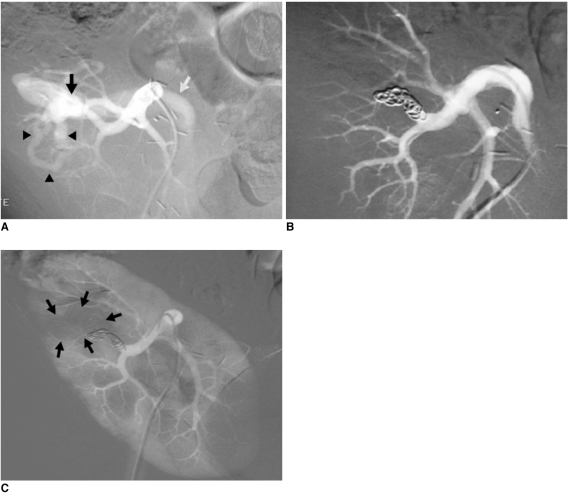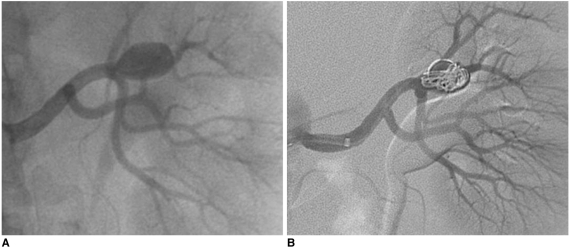Korean J Radiol.
2010 Jun;11(3):257-268. 10.3348/kjr.2010.11.3.257.
Transcatheter Arterial Embolization in Patients with Kidney Diseases: an Overview of the Technical Aspects and Clinical Indications
- Affiliations
-
- 1Russell H. Morgan Department of Radiology and Radiological Sciences, Division of Cardiovascular and Interventional Radiology, Johns Hopkins University School of Medicine, Johns Hopkins Hospital, Baltimore, Maryland 21287, USA. romaric.loffroy@yahoo.fr
- KMID: 946265
- DOI: http://doi.org/10.3348/kjr.2010.11.3.257
Abstract
- Therapeutic embolization is defined as the voluntary occlusion of one or several vessels, and this is achieved by inserting material into the lumen to obtain transient or permanent thrombosis in the downstream vascular bed. There are a number of indications for this approach in urological practice, in particular for the patients with parenchymatous or vascular kidney disease. In this review, we present the different embolization techniques and the principally employed occluding agents, and then we present the principal clinical indications and we discuss other pathologies that may benefit from this non-invasive therapy. The complications, side effects and main precautions associated with this approach are also described.
MeSH Terms
Figure
Reference
-
1. Loffroy R, Guiu B, Cercueil JP, Krausé D. Endovascular therapeutic embolization: an overview of occluding agents and their effects on embolised tissues. Curr Vasc Pharmacol. 2009; 7:250–263. PMID: 19356008.2. Park JH, Kim SH, Han JK, Chung JW, Han MC. Transcatheter arterial embolization of unresectable renal cell carcinoma with a mixture of ethanol and iodized oil. Cardiovasc Intervent Radiol. 1994; 17:323–327. PMID: 7533666.
Article3. Hiraki T, Mimura H, Gobara H, Fujiwara H, Iguchi T, Sakurai J, et al. Pulmonary edema as a complication of transcatheter embolization of renal angiomyolipoma in a patient with pulmonary lymphangioleiomyomatosis due to tuberous sclerosis complex. J Vasc Interv Radiol. 2009; 20:819–823. PMID: 19465308.
Article4. Ko JS, Kim JA, Do YS, Kwon MA, Choi SJ, Gwak MS, et al. Prediction of the effect of injected ethanol on pulmonary arterial pressure during sclerotherapy of arteriovenous malformations: relationship with dose of ethanol. J Vasc Interv Radiol. 2009; 20:39–45. PMID: 19028113.
Article5. Probert CS, Osborn DE, Watkin EM. Malignant hypertension due to embolisation of a clear cell renal carcinoma. Br J Urol. 1992; 70:95–96. PMID: 1638381.
Article6. Weckermann D, Schlotmann R, Tietze W, Häckel T. Gas formation after renal artery embolisation: genesis and clinical relevance. Urol Int. 1992; 49:211–214. PMID: 1475862.
Article7. Jafri SZ, Ellwood RA, Amendola MA, Farah J. Therapeutic angioinfarction of renal carcinoma: CT follow-up. J Comput Assist Tomogr. 1989; 13:443–447. PMID: 2470795.8. May M, Brookman-Amissah S, Pflanz S, Roigas J, Hoschke B, Kendel F. Pre-operative renal arterial embolisation does not provide survival benefit in patients with radical nephrectomy for renal cell carcinoma. Br J Radiol. 2009; 82:724–731. PMID: 19255117.
Article9. Houlle D, Reizine D, Ruffenacht D, Riche MC, Merland JJ. Embolization of iatrogenic traumatic vascular lesions of the kidney. Apropos of 25 cases. Ann Urol (Paris). 1986; 20:15–19. [French]. PMID: 3707072.10. Singh R, O'Brien T. The role of transarterial embolization in the treatment of renal cell carcinoma. BJU Int. 2004; 93:181. PMID: 14678398.
Article11. Bakal CW, Cynamon J, Lakritz PS, Sprayregen S. Value of preoperative renal artery embolization in reducing blood transfusion requirements during nephrectomy for renal cell carcinoma. J Vasc Interv Radiol. 1993; 4:727–731. PMID: 8280991.
Article12. Kim TH. Renal cell carcinoma in a horseshoe kidney and preoperative superselective renal artery embolization: a case report. Korean J Radiol. 2005; 6:200–203. PMID: 16145297.
Article13. Lanigan D, Jurriaans E, Hammonds JC, Wells IP, Choa RG. The current status of embolization in renal cell carcinoma -- a survey of local and national practice. Clin Radiol. 1992; 46:176–178. PMID: 1395422.
Article14. Kauffmann GW, Richter GM, Rohrbach R, Wenz W. Prolonged survival following palliative renal tumor embolization by capillary occlusion. Cardiovasc Intervent Radiol. 1989; 12:22–28. PMID: 2496923.
Article15. Guy L, Alfidja AT, Chabrot P, Ravel A, Boiteux JP, Boyer L. Palliative transarterial embolisation of renal tumors in 20 patients. Int Urol Nephrol. 2007; 39:47–50. PMID: 17310315.16. Maxwell NJ, Saleem Amer N, Rogers E, Kiely D, Sweeney P, Brady AP. Renal artery embolisation in the palliative treatment of renal carcinoma. Br J Radiol. 2007; 80:96–102. PMID: 17495058.
Article17. Kónya A, Choi BG, Van Pelt CS, Wright KC. Transcatheter arterial embolization of renal VX-2 carcinoma: ethiodol-ethanol capillary embolization combined with carboplatin. Korean J Radiol. 2007; 8:136–147. PMID: 17420631.
Article18. Flanigan RC. The failure of infarction and/or nephrectomy in stage IV renal cell cancer to influence survival or metastatic regression. Urol Clin North Am. 1987; 14:757–762. PMID: 3314066.
Article19. Soulen MC, Faykus MH Jr, Shlansky-Goldberg RD, Wein AJ, Cope C. Elective embolization for prevention of hemorrhage from renal angiomyolipomas. J Vasc Interv Radiol. 1994; 5:587–591. PMID: 7949715.
Article20. Williams JM, Racadio JM, Johnson ND, Donnelly LF, Bissler JJ. Embolization of renal angiomyolipomata in patients with tuberous sclerosis complex. Am J Kidney Dis. 2006; 47:95–102. PMID: 16377390.
Article21. Lenton J, Kessel D, Watkinson AF. Embolization of renal angiomyolipoma: immediate complications and long-term outcomes. Clin Radiol. 2008; 63:864–870. PMID: 18625350.
Article22. Hadley DA, Bryant LJ, Ruckle HC. Conservative treatment of renal angiomyolipomas in patients with tuberous sclerosis. Clin Nephrol. 2006; 65:22–27. PMID: 16429838.
Article23. Loffroy R, Guiu B, Lambert A, Mousson C, Tanter Y, Martin L, et al. Management of post-biopsy renal allograft arteriovenous fistulas with selective arterial embolization: immediate and long-term outcomes. Clin Radiol. 2008; 63:657–665. PMID: 18455557.
Article24. Dahami Z, Saghir O, Cherif Idrissi Elganouni N, Dakir M, Moudouni MS, Sarf I, et al. Renal stab wounds: about 20 cases. Prog Urol. 2009; 19:15–20. [French]. PMID: 19135637.25. Sofocleous CT, Hinrichs C, Hubbi B, Brountzos E, Kaul S, Kannarkat G, et al. Angiographic findings and embolotherapy in renal arterial trauma. Cardiovasc Intervent Radiol. 2005; 28:39–47. PMID: 15602636.
Article26. Cimsit NC, Baltacioglu F, Cengic I, Akpinar IN, Ilker Y, Turkeri L. Transarterial glue embolization in iatrogenic renovascular injuries. Int Urol Nephrol. 2008; 40:875–879. PMID: 18437524.
Article27. Maleux G, Messiaen T, Stockx L, Vanrenterghem Y, Wilms G. Transcatheter embolization of biopsy-related vascular injuries in renal allografts. Long-term technical, clinical and biochemical results. Acta Radiol. 2003; 44:13–17. PMID: 12630992.
Article28. Courtheoux P, Maiza D, Mani J, Mercier V, Theron J. Postnephrectomy arteriovenous fistula of the renal pedicle treated with detachable balloons: a case report. Cardiovasc Intervent Radiol. 1988; 11:340–342. PMID: 3145808.
Article29. Nosher JL, Needell GS, Bialy G, Zatina M. Catheter occlusion of a mycotic renal artery aneurysm with cure of associated renovascular hypertension. Cardiovasc Intervent Radiol. 1989; 12:310–312. PMID: 2516771.
Article30. Abath C, Andrade G, Cavalcanti D, Brito N, Marques R. Complex renal artery aneurysms: liquids or coils? Tech Vasc Interv Radiol. 2007; 10:299–307. PMID: 18572145.
Article31. Gutta R, Lopes J, Flinn WR, Neschis DG. Endovascular embolization of a giant renal artery aneurysm with preservation of renal parenchyma. Angiology. 2008; 59:240–243. PMID: 18403463.
Article32. Clark TW, Sankin A, Becske T, Nelson PK, Fox M. Stent-assisted Guglielmi detachable coil repair of wide-necked renal artery aneurysm using 3-D angiography. Vasc Endovascular Surg. 2007; 41:528–532. PMID: 18166635.33. Keller FS, Coyle M, Rosch J, Dotter CT. Percutaneous renal ablation in patients with end-stage renal disease: alternative to surgical nephrectomy. Radiology. 1986; 159:447–451. PMID: 3515422.
Article
- Full Text Links
- Actions
-
Cited
- CITED
-
- Close
- Share
- Similar articles
-
- Selective Arterial Embolization of Renal Arteriovenous Fistula and Arterial Aneurysm
- Outcomes and complications of embolization for gastrointestinal bleeding
- Transcatheter arterial embolization for congenital renal arteriovenous fistula
- Endovascular Treatment of Cerebral Aneurysms: Technical Options in Coil Embolization
- Transcatheter Arterial Embolization for Palliation of Uterine Body Cancer Bleeding

